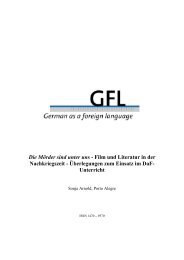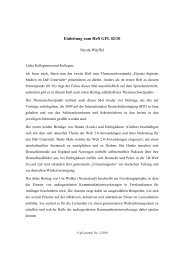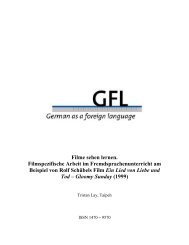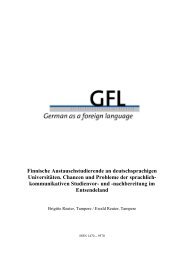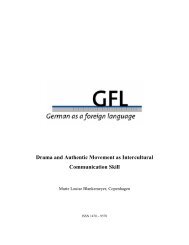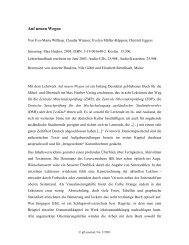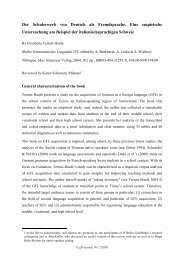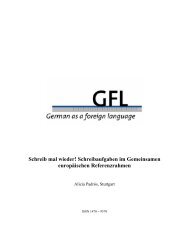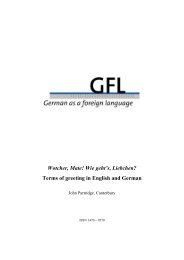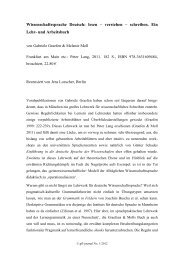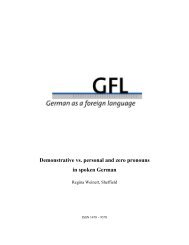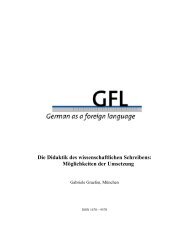Chainsaws and Neo-Nazis: Contemporary German ... - GFL-Journal
Chainsaws and Neo-Nazis: Contemporary German ... - GFL-Journal
Chainsaws and Neo-Nazis: Contemporary German ... - GFL-Journal
Create successful ePaper yourself
Turn your PDF publications into a flip-book with our unique Google optimized e-Paper software.
<strong>Chainsaws</strong> <strong>and</strong> <strong>Neo</strong>-<strong>Nazis</strong>: <strong>Contemporary</strong> <strong>German</strong><br />
Horror Film Production<br />
R<strong>and</strong>all Halle, Pittsburgh<br />
ISSN 1470 – 9570
R<strong>and</strong>all Halle<br />
<strong>Chainsaws</strong> <strong>and</strong> <strong>Neo</strong>-<strong>Nazis</strong>: <strong>Contemporary</strong> <strong>German</strong> Horror Film<br />
Production<br />
R<strong>and</strong>all Halle, Pittsburgh<br />
Although horror film production has a long history in <strong>German</strong>y, in <strong>German</strong> film studies<br />
discussions of the horror genre have focused almost exclusively on the silent era. For long<br />
decades production in the genre was almost solely the province of international coproductions<br />
done under low-budget conditions aimed at a mass audience. These<br />
circumstances made it an unlikely object of study for nationally oriented high cultural studies.<br />
This essay reviews this history of post-war horror films, arguing that <strong>German</strong> horror film<br />
production experienced a sudden significant shift at the time of unification <strong>and</strong> has continued<br />
on in newly invigorated forms that merit careful consideration. In the subcultural form of<br />
Wende Horror we find artefacts from the period of unification that open up discussion of<br />
social psychology. In the subsequent productions we discover mainstream transnational<br />
horror films that reflect the new conditions of film financing in the global era. The essay ends<br />
with six reflections oriented toward fostering the further study of <strong>German</strong> horror film.<br />
Horror films with their physical excitations, their gory effects, their special sub-cultural<br />
appeal, <strong>and</strong> their generic narratives, seem to offer little content for the serious student of<br />
<strong>German</strong> culture. Yet if we look back into the history of the horror genre we recognize at its<br />
origins a series of well-known, acclaimed images from <strong>German</strong>y. Films like Der Student<br />
von Prag, Der Golem, Caligari, Nosferatu, or M belong on the lists of the achievements of<br />
world cinema. 1 Still, inspite of the lasting impression of the uncanny somnambulist <strong>and</strong> his<br />
abject colleagues, contemporary studies of <strong>German</strong> film have largely disregarded the horror<br />
genre. Although Lotte Eisner <strong>and</strong> Siegfried Kracauer took the genre seriously in their era,<br />
most contemporary discussions of <strong>German</strong> horror films are simple, lurid pulp books that<br />
play on the fascinations of an established audience. Even in the significant reference work,<br />
the British Film Institute’s Companion to <strong>German</strong> Cinema, specifically oriented “towards<br />
popular traditions (the entertainment cinema, the despised, supposedly mediocre genres,<br />
<strong>and</strong> the stars <strong>and</strong> directors of popular cinema often unknown outside of their own<br />
countries)” (Elsaesser 1999: viii), the horror genre does not appear.<br />
1 See the annotated filmography for further films.<br />
© gfl-journal, No. 3/2006<br />
40
<strong>Contemporary</strong> <strong>German</strong> Horror Film Production<br />
The academic neglect is perhaps underst<strong>and</strong>able given that the Third Reich ostensibly<br />
ended production of horror films <strong>and</strong> the genre did not return easily to mainstream<br />
production in reconstruction <strong>German</strong>y. I would suggest though that the recuperation <strong>and</strong><br />
analysis of the horror genre has a certain magnitude given not only its past significance but<br />
because of its punctual reemergence at the time of the Wende <strong>and</strong> its subsequent secure<br />
return to contemporary mainstream film production. Thus this essay will begin with an<br />
overview of the history of the genre. It will then explore its reemergence starting in 1989,<br />
reflect on its causes, <strong>and</strong> attend to its overall significance for cultural production in<br />
<strong>German</strong>y. In the essay the history of the horror film in unified <strong>German</strong>y will be divided into<br />
two phases, the phase of sub-cultural Wende Horror (1989-1992) <strong>and</strong> the phase of<br />
mainstream Transnational Horror (1993-present). The essay will provide mainly an<br />
overview of production development. I have discussed Wende Horror extensively<br />
elsewhere with a particular focus on the social-psychological implications of this<br />
reemergence of the genre (Halle 2003). Here I am more interested in the move beyond the<br />
nationally specific underground period into the more commercial-based transnational films<br />
that dominate subsequent <strong>and</strong> contemporary production. In order to carry this out, I will try<br />
to focus some attention on two representative films: Christoph Schlingensief’s Das<br />
deutsche Kettensägenmassaker (1990) <strong>and</strong> Stefan Ruzowitzky’s Anatomie (2000). Finally<br />
the essay will end with six theses, or better Gedenkanstöße, regarding the general<br />
significance of the study of horror film.<br />
A cursory review of movie databases reveals that in the 56 years from 1933 to 1989, we can<br />
find 36 contributions to the horror genre in <strong>German</strong> most of which stem from the 1960s. 2<br />
To be sure this number is negotiable given that the parameters of the genre blend out into<br />
Krimis <strong>and</strong> thrillers as well as sex comedies with horror motifs. More difficult to ascertain<br />
in numbers are the numerous European co-productions, although certainly over 50. The<br />
international co-productions emerged primarily in the 1960s <strong>and</strong> flourished throughout the<br />
1970s, then tapered off in the 1980s. While they collapsed sexuality <strong>and</strong> horror, earning<br />
them the title “exploitation horror”, they nevertheless evidenced certain syntactic traits<br />
common to the earlier classic horror productions. At the same time, however, new here to<br />
2 Indexes consulted include, British Film Institute Film Index International, Complete Index to<br />
World Film, <strong>and</strong> The Internet Movie Database.<br />
© gfl-journal, No. 3/2006<br />
41
R<strong>and</strong>all Halle<br />
the “syntax” of the European productions were lurid sex scenes, significantly often relying<br />
on portrayals of queer sexuality, an aspect insightfully discussed by Andrea Weiss (1993).<br />
The titles alone provide insight into how these films negotiated cultural difference <strong>and</strong><br />
marketing draw (see annotated filmography). Such market negotiations were fundamental<br />
because the co-productions responded to the <strong>German</strong> film industry’s crisis of the late 1960s<br />
<strong>and</strong> they often relied on complicated agreements among mainly <strong>German</strong>, Spanish, Italian,<br />
<strong>and</strong> French production companies. Although they tended to have very low budgets <strong>and</strong><br />
production values, we also find among the co-productions significant big-budget<br />
contributions to New <strong>German</strong> Cinema, like Werner Herzog’s Nosferatu (1979). By the<br />
1980s, very few horror films were produced at all, although the <strong>German</strong> fanzine Splatting<br />
Image, the travelling Fantasy Filmfest, <strong>and</strong> alternative screening spaces kept a <strong>German</strong> fan<br />
base intact.<br />
Starting in 1989 there is a sudden jump in horror film production <strong>and</strong> in the next three years<br />
at least twelve full-length feature films were produced in <strong>German</strong>y (Halle 2003). Although<br />
with 12 films it seems exaggerated to talk about a horror wave, the sudden increase to about<br />
four films per year marks a significant <strong>and</strong> sudden jump in horror film production.<br />
Moreover given the underground nature of the films <strong>and</strong> the sudden rise in video<br />
distribution at this time, it is possible that through direct to video there are many more films<br />
from this period. Most significantly, these films broke with the older co-production<br />
strategies <strong>and</strong> they set something in motion so that after this initial wave, in the subsequent<br />
12 years from 1993 to 2005, over 100 horror films were produced. They also represent a<br />
qualitative change from the previous three decades of horror films. Films in the period from<br />
1989-1992 include Black Past (Ittenbach, 1989), Der Todesking (Buttgereit, 1989), <strong>German</strong><br />
Chainsaw Massacre [Das deutsche Kettensägenmassaker] (Schlingensief, 1990), My<br />
Lovely Monster (Bergmann, 1990), Nekromantik 2 [Nekromantik 2: Die Rückkehr der<br />
Liebenden Toten] (Buttgereit, 1991), Zombie ’90: Extreme Pestilence (Schnaas, 1991), The<br />
Burning Moon [Burning Moon: Dieser Film überschreitet alle Grenzen] (Ittenbach, 1992),<br />
Violent Shit II (Schnaas, 1992), Urban Scumbags vs. Countryside Zombies (Panneck;<br />
Hollmann, 1992), Babylon [Babylon - Im Bett mit dem Teufel] (Huettner, 1992), <strong>and</strong> Terror<br />
© gfl-journal, No. 3/2006<br />
42
<strong>Contemporary</strong> <strong>German</strong> Horror Film Production<br />
2000 - Intensivstation Deutschl<strong>and</strong> (Schlingensief, 1992). 3 The films by Ralf Huettner,<br />
Michael Bergmann, Sebastian Panneck, <strong>and</strong> Patrick Hollmann are furthermore debut films.<br />
If we look more closely at the films from 1989-1992, we note that these films lend<br />
themselves to be designated as Wende Horror (Halle 2003). The experience of unification<br />
was immediately thematized by Christoph Schlingensief’s 1990 production of Das deutsche<br />
Kettensägenmassaker <strong>and</strong> again in Terror 2000 – Intensivstation Deutschl<strong>and</strong> (1992).<br />
Beyond these films, we can recognize the anxieties of unification in the themes of films like<br />
Andreas Schnaas’s Zombie ’90 (1991) <strong>and</strong> Violent Shit II (1992), Alex Klutzny’s<br />
Blutgarten (1991), Olaf Ittenbach’s Black Past (1989) <strong>and</strong> The Burning Moon (1992), <strong>and</strong><br />
Jörg Buttgereit’s 1991 production of Nekromantik 2. What traits do these films share? In<br />
viewing them we would immediately notice that they are for the most part very low budget<br />
with rather crude production values incorporating older technologies like super 8. Their<br />
immediate release did not take place through typical distribution routes but was facilitated<br />
by sub-cultural, underground venues <strong>and</strong> through video <strong>and</strong> specialty video stores springing<br />
up. As such they actually represent a vanguard in new forms of production <strong>and</strong> distribution.<br />
As far as style, the films were in a line more with the tradition of slasher, trash, splatter, or<br />
euro gore films, a direction that had a fan base in <strong>German</strong>y but little actual precedent in<br />
<strong>German</strong> film history before 1989. Buckets of fake blood, butcher shop entrails, pasta for<br />
skin, <strong>and</strong> other kitchen cupboard special effects fill the frames of Wende Horror, oriented<br />
toward eliciting an experience of revulsion from their spectators. In general, they moved at<br />
a rapid pace, with cinematic mayhem displacing narrative development. Indeed the<br />
filmmakers often neglect story <strong>and</strong> continuity for a complicated irony <strong>and</strong> a cynical<br />
suspension of disbelief – Buttgereit is a notable exception here. If we underst<strong>and</strong> them as<br />
operating in the genre of “popular” film, these films do not appeal to a “mass audience” –<br />
rather, in their relation to mass consumption, they resemble the Young <strong>German</strong> Films of the<br />
1960s. They disrupt conventional distinctions of high <strong>and</strong> popular culture <strong>and</strong> exhibit a<br />
potential for avant-gardist practice.<br />
3 I have listed the English title first <strong>and</strong> placed the <strong>German</strong> title in brackets. Some films do not<br />
have English titles. Elsewhere, especially in the filmography, I have used a slash to denote<br />
multiple titles for co-produced versions of films.<br />
© gfl-journal, No. 3/2006<br />
43
R<strong>and</strong>all Halle<br />
Most discussed out of this group is Christoph Schlingensief who has been described as an<br />
enfant terrible of the stage, an artist of provocation, <strong>and</strong> a next generation filmmaker<br />
carrying on the tradition of New <strong>German</strong> Cinema. 4 In Schlingensief’s films <strong>and</strong> happenings<br />
we find actors who belong to the Fassbinder regulars of New <strong>German</strong> Cinema: Margit<br />
Carstensen, Volker Spengler, <strong>and</strong> Irm Hermann for example. Schlingensief’s bitingly<br />
satirical slasher / gore film Das deutsche Kettensägenmassaker appeared at the point of<br />
unification as a shockingly negative contribution in a media l<strong>and</strong>scape filled with positivity<br />
<strong>and</strong> no little triumphalism. At the heart of <strong>German</strong> Chainsaw, like the storyline of Texas<br />
Chainsaw (Hooper, 1974) on which it is based, is an economically impoverished butcher<br />
family. They recognize “cheap meat” in the East <strong>German</strong>s passing over the old border into<br />
the West <strong>and</strong> begin turning them into sausage. Clara, fleeing the murder of her husb<strong>and</strong> <strong>and</strong><br />
the decaying East, l<strong>and</strong>s in the h<strong>and</strong>s of the butchers. She is kept alive because the daughter<br />
of the family falls in love with her. This proves to be their downfall. Her escape in the end<br />
comes with the implosion of the entire milieu. The film received excessive commentary <strong>and</strong><br />
a great deal of bad publicity in the popular press, while academic assessments nervously<br />
elevated Schlingensief’s films to the level of high aesthetic form. However, as with the rest<br />
of this group of filmmakers, his work challenges the very categories used to appraise it. The<br />
films of Schlingensief, Buttgereit, Ittenbach, <strong>and</strong> Schnaas fall quickly out of any high<br />
cultural category, unless those categories can account for – as Jörg Buttgereit described it –<br />
the “making [of] art out of sleaze” (Kerekes 1998: 61). Interestingly the address of these<br />
underground films to a subcultural audience means that they have acquired a caché,<br />
resulting in greater lasting popularity <strong>and</strong> exposure than, say, the films of the Comedy<br />
Wave of the 1990s I have discussed elsewhere (Halle 2000). Years after their initial release<br />
these films continue to be screened, their format improved, <strong>and</strong> their international<br />
distribution on video exp<strong>and</strong>ed.<br />
The wave of Wende Horror set something in motion. Horror film production took off. It<br />
becomes difficult to trace out exactly the amount of production at this point. There is much<br />
direct to video work that remains isolated <strong>and</strong> travels in underground circles outside of<br />
major distribution mechanisms. Furthermore direct production for television increased as<br />
4 For a reading of Schlingensief’s 100 Jahre Adolf Hitler: Die letzte Stunde im Führerbunker<br />
(1988) see the contribution of Martin Brady <strong>and</strong> Helen Hughes to this volume.<br />
© gfl-journal, No. 3/2006<br />
44
<strong>Contemporary</strong> <strong>German</strong> Horror Film Production<br />
well <strong>and</strong> genre blending also brought forward a number of crossovers with the comedy<br />
format. If we apply “strict” generic definitions then films produced to the present include<br />
Schramm (Buttgereit, 1993), Amoklauf (Boll, 1994), Premutos: Der gefallene Engel [The<br />
Fallen Angel] (Ittenbach, 1997), Over My Dead Body [Nur über meine Leiche] (Matsutani,<br />
1995), The Deathmaker [Der Totmacher] (Kamarkar, 1995), Kiss My Blood (Jazay, 1998),<br />
Seven Moons [Sieben Monde] (Fratzscher, 1998), Anthropophagous 2000 (Schnaas, 1999),<br />
Holgi (Knarr, 1999), The 13 th Floor (Rusnak, 1999), The Valley of Shadows [Das Tal der<br />
Schatten] (Gutmann, 1999), Anatomy [Anatomie] (Ruzowitzky, 2000).<br />
Clearly, though, next generation film school students <strong>and</strong> independent filmmakers willing<br />
to accept the constraints of low-budget production developed by their predecessors have<br />
brought forward a further set of debut films in this tradition, many of them as direct to<br />
video, incorporating technological advancements, <strong>and</strong> marketed over the internet: see<br />
Baron of Darkness (del Mar, 1997), The Baron of Darkness 2, (Bellocchio, 1998), Berlin<br />
Snuff (Wind, 1995), BloodBound (Fleischer, 2005), Captain Cosmotic (Gosejohann,<br />
1998), The Dark Area (Hummell, 2000), The Dark Rock (Holzner, 2004), Diabolica<br />
(Vogt, 1999), Dämonenbrut (Bethmann, 2000), Fog² – Revenge of the Executed (Krekel,<br />
2002), Garden of Love (Ittenbach, 2003), Die Insel der Dämonen (Bethmann, 1998),<br />
Kinder der Nacht 1 (Bender, 2000), Midnight’s Calling (Rose, 2000), Mutation (Fehse;<br />
Rose, 1999), Mutation 2 – Generation Dead (Rose, 2001), Mutation 3 – Century of the<br />
Dead (Rose, 2002), Noctem (Wolf, 2003), Psychokill – Tod der Schmetterlinge (Taubert,<br />
2001), Rigor Mortis – The Final Colours (Rose, 2003), Rossa Venezia (Bethmann, 2003),<br />
Space Wolf (Rose, 2003), Tales of Madness (von Euw, 1999), Tanz der Kürbisköpfe<br />
(Bethmann, 1996), Der Todesengel (Fischer, 1998). While these films are national in their<br />
production they derive from <strong>and</strong> contribute to a global cinematic horror repertoire. They<br />
tend to remain underground, although they can evidence technological expertise <strong>and</strong><br />
sometimes afford their makers a move into the mainstream media industry. However the<br />
subcultural popularity of the horror genre <strong>and</strong> the limited budgets available ultimately had<br />
an enervating effect on some of the older filmmakers. In order to appeal to a broader<br />
audience, Schlingensief shifted his profile away from film, devoting his energies to stage,<br />
installation, broadcast, <strong>and</strong> performance arts, while Buttgereit, lacking a breakthrough into<br />
bigger budget productions, has turned his attention to publishing <strong>and</strong> film programming.<br />
© gfl-journal, No. 3/2006<br />
45
R<strong>and</strong>all Halle<br />
The truly big break of the horror genre into the mainstream came from outside this milieu<br />
entirely, from within new branches of the film industry revitalized by major reforms.<br />
In sum then, given the punctual point of emergence of these films in a mode of production<br />
peripheral to the culture industry or industrialized modes of production, there is a<br />
specificity in Wende Horror. The genre might not have told tales that everyone wanted to<br />
hear, yet, as a shift in genre conventions, these movies offered tales that did derive from<br />
<strong>and</strong> addressed their particular moment. In general, genres, I want to suggest, indicate<br />
social-psychological processes. Genre conventions, deriving from a certain repetition-<br />
variation on themes <strong>and</strong> motifs, answer an apparent need for a group of people to hear the<br />
same tale told over <strong>and</strong> over again. When genre conventions shift, they indicate a shift in<br />
social dynamics or a development of new psychological needs. The horror genre holds a<br />
particular potential to help spectators address periods of chaos <strong>and</strong> destabilization –<br />
individual or communal. As we can trace the emergence of Expressionist Horror to the<br />
aftermath of World War I, or Hollywood Universal Horror in the 1930s to the disruption<br />
<strong>and</strong> social fragmentation unleashed by the Great Depression, we can likewise recognize<br />
Wende Horror as responding to the ruptures <strong>and</strong> discontinuities of the period of <strong>German</strong><br />
unification. In comparison to these other transformative moments in the horror genre,<br />
Wende Horror’s lack of popular appeal does not denote a lack of its social-psychological<br />
potential to address this period, rather it suggests a failure of that potential to find a popular<br />
audience.<br />
If these observations on the social-psychological function of Wende Horror seem too<br />
quickly sketched out, let me underscore again that I have addressed this phenomenon in<br />
extensive detail elsewhere (Halle 2003). I gloss that discussion here in order to draw out a<br />
dynamic I left under explored in that discussion. There was in Wende Horror a mode of<br />
specificity that oriented it toward a national audience. We can say a great deal about this<br />
national orientation; e.g. it was, as evidenced very well by Schlingensief’s work discussed<br />
above, an anti-nationalist orientation. However, it had a primarily allegorical, anti-realist<br />
relationship to local socio-political transformations. The narratives destabilize gender <strong>and</strong><br />
sexuality in such a way as to make them unassimilatable to traditional nationalist polarities<br />
of masculine males <strong>and</strong> feminine females. The filmmakers who contributed to Wende<br />
Horror had a clear <strong>and</strong> thorough underst<strong>and</strong>ing of mainstream Hollywood horror films; <strong>and</strong><br />
© gfl-journal, No. 3/2006<br />
46
<strong>Contemporary</strong> <strong>German</strong> Horror Film Production<br />
they rejected the tropes <strong>and</strong> motifs of those films. We could, thus, explore these films as<br />
exemplifying a resistance to American cultural hegemony. Or, we can focus on how Wende<br />
Horror marks the (unintentional) culmination of the national ensemble of filmmaking. The<br />
Oberhausen Manifesto initiated this ensemble <strong>and</strong> it developed as the <strong>German</strong> New Wave.<br />
These films mark the end of this ensemble because they emerged just at the point before the<br />
radical transnational reformation of the European film industries that would take place in<br />
the mid-1990s. This last point proves most important for the exploration at h<strong>and</strong>.<br />
Inspired by the crisis in film production at the start of the 1990s, government subsidy<br />
institutions <strong>and</strong> industry leaders instituted a massive restructuring in the industry. In less<br />
than a decade, film production was transformed from a public-subsidized, national industry<br />
of primarily high cultural production to a private, transnational system oriented toward<br />
profitability. Entertainment <strong>and</strong> mass market genre films became more significant, resulting<br />
first in the Comedy Wave of the 1990s <strong>and</strong> then in an expansion to other genres. In 2000,<br />
with the debut of Stefan Ruzowitzky’s Anatomie, the <strong>German</strong> film industry presented its<br />
first commercially successful big-budget horror film since the Third Reich. But before we<br />
engage in national triumphalism, we must remark that it is a film which only superficially<br />
represents a national form of production. If we look more closely at this film, we recognize<br />
how after the reforms of the 1990s transnationalism shapes contemporary film-making in<br />
<strong>German</strong>y.<br />
Around 1998 in order to take advantage of industry <strong>and</strong> market transformations Columbia<br />
Tristar established a <strong>German</strong> subsidiary, Deutsche Columbia. Deutsche Columbia entered<br />
into an agreement with the production company of Claussen & Wöbke to bring out a big-<br />
budget horror film as a way of capitalizing on untapped markets <strong>and</strong> genres. The general<br />
success of Silence of the Lambs (Demme, 1991) <strong>and</strong> Scream (Craven, 1996) had proved<br />
that there was indeed a mainstream market for horror films. But the few attempts to draw<br />
horror elements into the Comedy Wave films hardly served as a sufficient contribution; e.g.<br />
films like Nur über meine Leiche (Matsutani, 1995) <strong>and</strong> Kondom des Grauens (Walz,<br />
1996). Both production companies agreed the time was ripe. Claussen & Wöbke,<br />
production company of Nach Fünf im Urwald (Schmid, 1995) <strong>and</strong> the Oscar nominated<br />
Jenseits der Stille (Link, 1996), promised to supply an important insider knowledge of the<br />
© gfl-journal, No. 3/2006<br />
47
R<strong>and</strong>all Halle<br />
local film scene, while Deutsche Columbia offered a block-buster budget <strong>and</strong> access to the<br />
Columbia Tristar global distribution network.<br />
From this starting point, the film quickly took on a transnational orientation. They signed<br />
on Ruzowitzky, an Austrian director, who had proven himself adept at innovating genre<br />
films through his socially critical Heimatfilm, Die Siebtelbauern. They hoped he would<br />
bring the same energy to bear on the horror genre. Further significant for the film’s appeal,<br />
they signed on Franka Potente in the leading role. Potente had debuted in Nach fünf, <strong>and</strong><br />
was experiencing at that time the international success of Lola rennt (1998) making her a<br />
box office draw. Finally for its props the film drew on the plasticized cadavers of Gunther<br />
von Hagens. Von Hagens, an anatomist from Heidelberg, had displayed these cadavers in<br />
his controversial Körperwelten exhibit, which in spite of controversy is still travelling <strong>and</strong><br />
has drawn over 18 million visitors as of February 2006. These factors, they hoped, would<br />
open up new markets for a horror film from <strong>German</strong>y.<br />
While such considerations clearly seek to find a valence within cultural specificity, let us<br />
make a distinction here between these market-driven motivations <strong>and</strong> the social-<br />
psychological motivations of underground Wende Horror. I do not want to claim<br />
authenticity for Wende Horror; however, it does seem to have addressed a particular local /<br />
national need in a way that the marketing of interest did not. Rather the production of<br />
Anatomie seems more clearly oriented to participating in the circle of retroactive need that<br />
characterizes the culture industry than appealing to local or national experience.<br />
In Anatomie Potente plays Paula, a medical student who has received a stipend to spend the<br />
summer studying at a famous anatomy seminar in Heidelberg. When a friend she had<br />
recently made shows up as a corpse on her dissection table, she begins to suspect that<br />
something worse than student hazing is at play in Heidelberg’s medical programme. Paula<br />
stumbles on references to a group of “Anti-Hippocrats”, a conspiratorial lodge of doctors<br />
that traces its roots to the medical experiments of the Nazi era. She learns that her own<br />
gr<strong>and</strong>father was a member <strong>and</strong> the inventor of “Promidal”, the chemical solution used to<br />
accomplish the preservation of the bodies – a solution that has to be administered while the<br />
body is still alive. In the end a fanatic Anti-Hippocrat, Hein (Benno Fürmann), chases Paula<br />
through the stark <strong>and</strong> sterile environments of the anatomy building as she struggles against<br />
© gfl-journal, No. 3/2006<br />
48
<strong>Contemporary</strong> <strong>German</strong> Horror Film Production<br />
the effects of a Promidal injection. Paula kills Hein but in an epilogue scene we are<br />
reminded that her actions have only dispersed the Anti-Hipporcrat lodge not closed it down,<br />
thereby establishing the basis for the sequel.<br />
The film appears as a <strong>German</strong> film, yet it is a <strong>German</strong> film made to circulate outside of<br />
<strong>German</strong>y. More than the touristy backdrop of Heidelberg or von Hagens’s creepy cadavers,<br />
the Nazi storyline inscribes the film in <strong>German</strong> culture. The trope of the evil Nazi scientist<br />
has a long cinematic history. A superficial list of the cultural appeal of evil Nazi scientists<br />
includes: Revenge of the Zombies (Sekely, 1943), The Torture Chamber of Baron Blood<br />
[Gli Orrori del castello di Norimberga] (Bava, 1972), Zaat (Barton, 1975), Bloodsucking<br />
Nazi Zombies [La Tumba de los muertos vivientes / Der Abgrund der lebenden Toten]<br />
(Franco, 1983), Hell Hunters (von Theumer, 1986), Legend of the Demon Womb [Shin<br />
chôjin densetsu Urotsukidôji: Mataiden] (Takayama, 1993). Here though, rather than an<br />
impossible character ruling over zombie hoards in a Latin American jungle, the film<br />
attempts to represent a particular <strong>German</strong> horror, the unknown war criminal in one’s own<br />
family. But the film’s engagement with <strong>German</strong> social psychology remains superficial <strong>and</strong><br />
here is where its transnational rather than its national specificity comes to play a significant<br />
role. The storyline proves more determined by a globalized financing apparatus <strong>and</strong> a<br />
transnational marketing strategy than a commitment to national history. The inscription in<br />
<strong>German</strong> culture proves superficial; more important is the young cast, the hip music, the<br />
genre, <strong>and</strong> the proven international ability of the props to elicit an experience of revulsion.<br />
These components prepared the film for a leap into the global youth market.<br />
Transnational filmmaking in this fashion harkens back to the earlier international co-<br />
productions, yet the arrangements are now directed primarily across the Atlantic. Typical of<br />
this strategy of filmmaking, the film reveals two axes. Its content <strong>and</strong> cast correspond to a<br />
national horizontal axis while its production <strong>and</strong> distribution strategies belong to a vertical<br />
transnational axis. This latter axis in particular is determined by a globalized Hollywood<br />
media industry. The national axis, the strength of its engagement with local social<br />
psychology, is subordinate to the transnational orientation of the film. Just two years later<br />
Resident Evil (Anderson, 2002), although filmed largely in <strong>and</strong> around Berlin with more of<br />
a European funding base, exhibits no engagement with <strong>German</strong> or European specificity.<br />
© gfl-journal, No. 3/2006<br />
49
R<strong>and</strong>all Halle<br />
There is much more that could be said about horror production <strong>and</strong> transnational film<br />
production in general. But in order to draw to a close, I will seek to distil out of this<br />
overview of production history six reflections on the significance of horror film since<br />
unification <strong>and</strong> how further study of <strong>German</strong> horror film production might prove critically<br />
productive.<br />
Horror films do not simply represent low or popular forms of cultural production, which we<br />
can deem as unworthy of the attention of traditionally high culture oriented <strong>German</strong><br />
Studies. Horror film production rather can undermine borders between high <strong>and</strong> low<br />
because it shares traditional concerns of the avant-garde: moral shock, challenge to<br />
censorship, mass orientation, aestheticization of popular forms, <strong>and</strong> so on. Moreover, in<br />
their typical marginal cult status European horror productions <strong>and</strong> non-Hollywood horror<br />
films in general have occupied a central position in the history of art film. We can benefit<br />
from future studies of the horror genre that explore what direct connection can be made,<br />
e.g., from Das Kabinett des Doktor Caligari (Wiene, 1920), through Andy Warhol’s<br />
Frankenstein (Morrissey; Margheriti, 1973), to Das deutsche Kettensägenmassaker<br />
(Schlingensief, 1990).<br />
The study of the history of horror film production in Europe disturbs national boundaries<br />
given that since the 1960s it has been largely a matter of co-productions. European Film<br />
Studies has taken place largely within national disciplines <strong>and</strong> discourses. Such study has<br />
not proved able to apprehend the co-productions that dominated the European film industry<br />
in the second half of the Twentieth Century. In the realm of B-grade Spanish-<strong>German</strong>-<br />
Italian-French-Monagassean co-productions from the 1970s we can identify a foundation of<br />
contemporary European transnational film production. Co-productions contractually drew<br />
together national resources. The EU has set up parameters that sublate these older forms of<br />
inter-national agreement into a more efficient mode of production. This enormous body of<br />
film production, however, is rarely the object of serious study not because of its aesthetic<br />
quality but because of the primarily national orientation of academic training <strong>and</strong> research.<br />
Further study of the European co-productions will challenge national orientations. They<br />
will prove an excellent object of analysis through which we can develop new critical skills<br />
theoretically strong enough to engage the era of globalization. This is not to suggest that we<br />
have to give up on national frameworks; certainly there are nationally specific modes of<br />
© gfl-journal, No. 3/2006<br />
50
<strong>Contemporary</strong> <strong>German</strong> Horror Film Production<br />
film production. However if we add to our national framework an international <strong>and</strong><br />
transnational one as well, we will better apprehend the full parameters of production.<br />
If I alluded to the ability of Wende Horror to act as a challenge to American cultural<br />
imperialism, this observation requires a corrective. In the transnational era, Hollywood is<br />
less a location in California <strong>and</strong> more a global configuration of production <strong>and</strong> distribution<br />
forces. Wende Horror might have been outside the global culture industry, but it exhibits no<br />
qualities that make it fundamentally resistant to that industry. Indeed if we focus on the<br />
transition of Wende to Transnational Horror, we can observe how in the next generation of<br />
underground filmmakers many actively sought linkage to mainstream mechanisms of<br />
distribution, exhibition, <strong>and</strong> production. For the global culture industry, the historic<br />
marginal status <strong>and</strong> subcultural orientation of horror production in <strong>German</strong>y <strong>and</strong> Europe in<br />
general turned it into a repository of film experiments upon which it can ultimately draw<br />
for mainstream narratives. <strong>German</strong> horror film production offers rich resources for the<br />
study of this dynamic of influence <strong>and</strong> linkage.<br />
We all know the experience of horror, but the vehicles designed to convey that experience<br />
are not universal. To be sure the horror genre’s strongest appeal tends currently to be with<br />
adolescent audiences across cultures. However, horror evidences a specificity of time,<br />
place, age group, subcultural identification, <strong>and</strong> individual psychology. What frightens in<br />
one era or place may not in another. It is this quality that allows changes in the horror genre<br />
to be taken generally to represent cultural transformations. The study of the social-<br />
psychological function of genre can allow scholars <strong>and</strong> critics to go beyond the impasse in<br />
genre studies that derives from structuralist-formalist approaches. We can explore in new<br />
ways the specificity of experience deriving from national, gender, or age positions if we<br />
keep in mind that the horror genre reemerged at the time of the Wende, that it disappeared<br />
from <strong>German</strong> film production for decades, that it appeals to adolescents, <strong>and</strong> so on.<br />
When sudden emergences or shifts in genre tendencies take place we can recognize horror<br />
films as fulfilling a broader social-psychological function. Horror film can serve an<br />
individual-psychological function for its spectators <strong>and</strong> it can also serve a mass-oriented<br />
social-psychological function. The boundaries of the two are naturally confused by film’s<br />
quality as mass medium. Further study of <strong>German</strong> horror films would allow us to articulate<br />
© gfl-journal, No. 3/2006<br />
51
R<strong>and</strong>all Halle<br />
more precisely this relationship. Tendentiously, I will suggest here that mainstream film<br />
industry productions aim more generally at individual psychology, or ahistorical categories<br />
e.g. teenage angst. Transnational <strong>and</strong> international horror production can replace historical<br />
<strong>and</strong> cultural specificity with other non-specific forms of fright.<br />
Anglo-American psychological-structural analyses of horror film consistently differentiate<br />
between three different effects on the audience. The terminology differs but overlaps. For<br />
instance Noël Carroll suggests suspense, mystery, horror, while Stephen King offers terror,<br />
horror, revulsion or “gross out”. It is useful to reflect on the extent to which such terms<br />
evidence a form of culturally specific experience. We know that <strong>German</strong> has added to<br />
English further descriptions of emotional states: Angst <strong>and</strong> the experience of das<br />
Unheimliche. Further studies of <strong>German</strong> horror film can help articulate what descriptive<br />
possibilities such terms as Gruseln, Grauen, Grausen, schaudern, schauern, fürchten, <strong>and</strong><br />
mitleiden contain. What can we learn by thinking about the idiosyncratic concern with the<br />
Doppelgänger versus the general deployment of evil Nazi scientists <strong>and</strong> their fascist<br />
zombies? The different linguistic fields here must describe nuances in the experience of<br />
horror, while the differing fascinations can indicate for us local <strong>and</strong> specific psycho-social<br />
concerns.<br />
References<br />
Altmann, Rick (1999) Film / Genre. London: BFI Publishing.<br />
Rohlf, Oliver (1998) Schreddern & Fleddern: Horror-König wider Willen: Das 3001 zeigt<br />
eine Retrospektive mit Werken des Splatter-Filmers Jörg Buttgereit. taz [Hamburg] 8<br />
July, 23.<br />
Benshoff, Harry (1997) Monsters in the Closet: Homosexuality <strong>and</strong> the Horror Film.<br />
Manchester: Manchester UP.<br />
Bronfen, Elisabeth (1992) Over Her Dead Body: Death, Femininity <strong>and</strong> the Aesthetic. New<br />
York: Routledge.<br />
Carol, Noël (1990) The Philosophy of Horror, or, Paradoxes of the Heart. New York:<br />
Routledge.<br />
Clover, Carol (1993) Men, Women, <strong>and</strong> Chain Saws: Gender in the Modern Horror Film.<br />
London: BFI.<br />
Coates, Paul (1991) The Gorgon’s Gaze: <strong>German</strong> Cinema, Expressionism, <strong>and</strong> the Image<br />
of Horror. Cambridge: Cambridge University Press.<br />
© gfl-journal, No. 3/2006<br />
52
<strong>Contemporary</strong> <strong>German</strong> Horror Film Production<br />
Coates, Paul (1994) Film at the Intersection of High <strong>and</strong> Mass Culture. Cambridge:<br />
Cambridge University Press.<br />
Creed, Barbara (1993) The Monstrous-Feminine: Film, Feminism, Psychoanalysis.<br />
London: Routledge.<br />
Eisner, Lotte H (1973) The Haunted Screen: Expressionism in the <strong>German</strong> Cinema <strong>and</strong> the<br />
Influence of Max Reinhardt. London: Secker <strong>and</strong> Warburg.<br />
Elsaesser, Thomas; Michael Wedel (eds) (1999) The BFI Companion to <strong>German</strong> Cinema.<br />
London: BFI Publishing.<br />
Freud, Sigmund (1966) The Uncanny. In: The St<strong>and</strong>ard Edition of the Complete<br />
Psychological Works of Sigmund Freud. Vol. 18. London: Hogarth Press.<br />
Grant, Barry Keith (1996) Planks of Reason: Essays on the Horror Film. Lanham:<br />
Scarecrow Press.<br />
Grant, Barry Keith (ed.) (1996) Dread of Difference: Gender <strong>and</strong> the Horror Film. Austin:<br />
University of Texas Press.<br />
Grant, Barry Keith (ed.) (1995) Film Genre Reader II. Austin: University of Texas Press.<br />
Halle, R<strong>and</strong>all (2000) “Happy Ends” to crises of heterosexual desire: toward a social<br />
psychology of recent <strong>German</strong> comedies. Camera Obscura 44, 1-39.<br />
Halle, R<strong>and</strong>all (2003) Unification horror: queer desire <strong>and</strong> uncanny visions. In: R<strong>and</strong>all<br />
Halle; Margaret McCarthy (eds) Light Motives: <strong>German</strong> Popular Film in Perspective.<br />
Detroit: Wayne State, 281-303.<br />
Hermann, Max (1997) Eine Begegnung mit Jörg Buttgereit. Artechock Filmmagazin 22<br />
http://www.artechock.de/film/text/artikel/1997/05_29_a.htm (accessed 17 August<br />
2006).<br />
Kerekes, David (1998) Sex, Murder, Art: The Films of Jörg Buttgereit. Manchester: Head<br />
Press.<br />
King, Stephen (1982) Danse Macabre. New York: Berkeley Books.<br />
Kristeva, Julia (1982) Powers of Horror: An Essay on Abjection. New York: Columbia.<br />
Kracauer, Siegfried (1974) From Caligari to Hitler: A Psychological History of the<br />
<strong>German</strong> Film. Princeton: Princeton University Press.<br />
Pinedo, Isabel Cristina (1997) Recreational Terror: Women <strong>and</strong> the Pleasures of Horror<br />
Film Viewing. Albany: State University of New York Press.<br />
Prawer, Siegbert Salomon (1989) Caligari’s Children: The Film as Tale of Terror. New<br />
York: Da Capo Press.<br />
Weiss, Andres (1993) Vampires <strong>and</strong> Violets: Lesbians in Film. New York: Penguin.<br />
Williams, Linda (1996) When the woman looks. In: Barry Keith Grant (ed.) Dread of<br />
Difference: Gender <strong>and</strong> the Horror Film. Austin: University of Texas Press, 15-34.<br />
Annotated Filmography: <strong>German</strong> Horror Film Production<br />
Selection of <strong>German</strong> horror films 1918-1932<br />
© gfl-journal, No. 3/2006<br />
53
R<strong>and</strong>all Halle<br />
Arlaune (Illes, 1918)<br />
Der Bucklige und die Tänzerin (Murnau, 1920)<br />
Cagliostro (Schünzel, 1921)<br />
Das Geheimnis des blauen Zimmers (Engel, 1932)<br />
Genuine (Wiene, 1920)<br />
Der Golem, wie er in die Welt kam (Wegener, 1920)<br />
Der Hund von Baskerville (Zehn, 1920)<br />
Der Januskopf (Murnau, 1920)<br />
Nachtgestalten (Oswald, 1919)<br />
Orlacs Hände (Wiene, 1924)<br />
Die Pest in Florenz (Lang, 1919)<br />
Der Student von Prag (Galeen, 1926)<br />
Totentanz (Rippert, 1919)<br />
Unheimliche Geschichten (Oswald, 1919)<br />
Unheimliche Geschichten (Oswald, 1932)<br />
Vampyr: Der Traum des Allan Grey (Dreyer, 1932)<br />
Wahnsinn (Veidt, 1919)<br />
Das Wachsfigurenkabinett (Birinsky, 1924)<br />
<strong>German</strong> horror films 1933-1989<br />
Die B<strong>and</strong>e des Schreckens (Reinl, 1960) EW (Edgar Wallace Film)<br />
Die Blaue H<strong>and</strong> (Vohrer, 1967) EW<br />
Der Bucklige von Soho (Vohrer, 1966) EW<br />
Der Fan (Schmidt, 1982). Capitalized on Neue deutsche Welle with a cannibalistic twist.<br />
Geburt der Hexe (Minks, 1980)<br />
Der Gorilla von Soho (Vohrer, 1968) EW<br />
Der Henker von London (Zbonek, 1963) EW<br />
Hexen bis aufs Blut gequält [Burn, Witch, Burn] (Armstrong; Hoven, 1970). With Udo<br />
Kier in a leading role.<br />
Hexen geschändet und zu Tode gequält (Hoven, 1973). Sequel to Hexen bis aufs Blut<br />
gequält.<br />
Der Hund von Blackwood Castle (Vohrer, 1968) EW<br />
Im Schloß der blutigen Begierde (Hoven, 1968).<br />
Jonathan (Geissendörfer, 1970). Dracula adaptation.<br />
Loft (Schmidt, 1985)<br />
Magdalena, vom Teufel besessen (Boos, 1974). Made in the wake of The Exorcist.<br />
Nachtschatten (Schilling, 1972). Schilling’s first film as director.<br />
Die Nackte und der Satan (Trivas, 1959). A <strong>German</strong> version of The Brain that would not<br />
Die.<br />
© gfl-journal, No. 3/2006<br />
54
<strong>Contemporary</strong> <strong>German</strong> Horror Film Production<br />
Necronomicon: Geträumte Sünden (Franco, 1968). Franco has directed over 180 films,<br />
most of them co-productions with significant <strong>German</strong> participation. This film is<br />
backed solely by <strong>German</strong> funding with an international cast.<br />
Nekromantik (Buttgereit, 1987)<br />
Das Phantom von Soho (Gottlieb, 1964) EW<br />
Der Rächer (Anton, 1960) EW<br />
Reise ins Jenseits: Die Welt des Übernatürlichen (Olsen, 1977). Documentary horror.<br />
Director used structure of documentary genre as vehicle for horror <strong>and</strong> revulsion.<br />
Die Säge des Todes (Franco, 1981). Franco has directed over 180 films, most of them coproductions<br />
with significant <strong>German</strong> participation. This film is backed solely by<br />
<strong>German</strong> funding with an international cast.<br />
Die Schlangengrube und das Pendel (Reinl, 1967). With an international cast including<br />
Christopher Lee.<br />
Der schwarze Abt (Gottlieb, 1963) EW<br />
Scotl<strong>and</strong> Yard jagt Dr. Marbuse (May, 1963)<br />
Sieben Tage Frist (Vohrer, 1969)<br />
Das Testament des Dr. Marbuse (Klingler, 1962). Third in the series started by Lang’s<br />
classic at the end of the Weimar Republic.<br />
Der Todesking (Buttgereit, 1989)<br />
Die Totenaugen von London (Vohrer, 1961) EW<br />
Traumstadt (Schaaf, 1973)<br />
Das Ungeheuer von London City (Zbonek, 1964) EW<br />
Die Unsichtbaren Krallen des Dr. Mabuse (Reinl, 1962)<br />
Violent Shit (Schnaas, 1987). Schnaas’s debut film <strong>and</strong> the first significant <strong>German</strong> gore<br />
film with two sequels to date.<br />
Der Würger von Schloß Blackmoor (Reinl, 1963) EW<br />
Zärtlichkeit der Wölfe (Lommel, 1973). The film was a project of the Fassbinder crew <strong>and</strong><br />
can be seen as a precursor of their work with Schlingensief.<br />
Der Zinker (Vohrer, 1963) EW<br />
Films with horror effects during the Third Reich<br />
Fährmann Maria (Wysber, 1936). Exception during the Third Reich with motifs recalling<br />
Lang <strong>and</strong> Expressionist silent films.<br />
Der Hund von Baskerville (Lamac, 1936). Exception during the Third Reich.<br />
Selection of sex, sexploitation <strong>and</strong> comedy films with horror motifs 1970-1989<br />
Beiß mich, Liebling (Förnbacher, 1970), Horror/comedy.<br />
Der Biß (Enzensberger, 1984). Horror/musical/underground. Marianne Enzensberger is a<br />
Rosa von Praunheim collaborator.<br />
Blutige Exzesse im Führerbunker (Buttgereit, 1984). Early short film.<br />
© gfl-journal, No. 3/2006<br />
55
R<strong>and</strong>all Halle<br />
Gebissen wird nur nachts (Francis, 1971). <strong>German</strong> sex comedy with horror motifs. Other<br />
titles include: Happening der Vampire.<br />
Graf Dracula beißt jetzt auch in Oberbayern (Schenkel, 1979). <strong>German</strong> sex comedy with<br />
horror motifs.<br />
Greta: Haus ohne Männer (Franco, 1977). <strong>German</strong>-Swiss co-production done by Jesus<br />
Franco as part of his Ilsa porn series. Other titles include: Greta the Torturer; Greta,<br />
the Mad Butcher; Greta, the Sadist; Ilsa: the Wicked Warden; Ilsa: Absolute Power;<br />
<strong>and</strong> W<strong>and</strong>a, the Wicked Warden.<br />
Hollywood-Monster (Emmerich, 1987). Horror comedy with American cast filmed in<br />
English.<br />
Horror Heaven (Buttgereit, 1984). Early short.<br />
Lady Dracula (Gottlieb, 1978). Horror/sex comedy.<br />
Selection of <strong>German</strong> horror co-productions 1960-1989<br />
Angst (Kargl, 1983). <strong>German</strong>-Austrian co-production.<br />
The Blood of Fu Manchu (Franco, 1968). Spanish-<strong>German</strong>.<br />
Bloodsucking Nazi Zombies [La Tumba de los muertos vivientes/Der Abgrund der lebenden<br />
Toten] (Franco, 1983). Spanish-Italian-<strong>German</strong>-French co-production. The story<br />
revolves around an army of Nazi zombies rather than Franco’s typical sexploitation.<br />
The mainstreaming of pornography <strong>and</strong> the reduction in co-production agreements<br />
required Franco to move in different directions.<br />
Bluebeard (Dmytryk, 1972). <strong>German</strong>-Italian-Hungarian co-production with Richard Burton<br />
<strong>and</strong> Raquel Welch.<br />
The Brides of Fu Manchu (Sharp, 1966). British-<strong>German</strong> Alan Towers co-production.<br />
La Casa dell’esorcismo (Bava, 1973). Italian-<strong>German</strong>-Spanish co-production with Telly<br />
Savalas <strong>and</strong> Elke Sommer in the same year as The Exorcist.<br />
Circle of Fear [Das Rätsel des silbernen Dreieck] (Jacobs; Moxey, 1966) EW. <strong>German</strong>-<br />
British two language version co-production. An Edgar Wallace film with Christopher<br />
Lee <strong>and</strong>, in a minor role, Klaus Kinski.<br />
Count Dracula (Franco, 1970). <strong>German</strong>-Italian-Spanish co-production with Christopher<br />
Lee.<br />
Diabólica malicia (Kelly; Biannchi, 1972) Italian-<strong>German</strong>-Spanish-British co-production<br />
with Mark Lester, Britt Ekl<strong>and</strong> <strong>and</strong> Hardy Krüger.<br />
Devil Hunter [Il Cacciatore di uomini/ Chasseur de l’enfer/ Jungfrau unter Kannibalen/<br />
M<strong>and</strong>ingo Manhunter/ Sexo Cannibal] (Franco, 1980) French-Spanish-<strong>German</strong> coproduction.<br />
Doctor Jekyll et les femmes (Borowczyk, 1981). French-<strong>German</strong> co-production by Polish<br />
director starring Udo Kier.<br />
L’Etrusco uccide ancora (Crispino, 1972). <strong>German</strong>-Yugoslavian co-production with Nadja<br />
Tiller in supporting role.<br />
Eugenie [De Sade 70/ Decameron francese/ Eugenie: the Story of her Journey into<br />
Perversion/ Les Inassouvies/ La Isla de la muerte/ Die Jungfrau und die Peitsche/<br />
© gfl-journal, No. 3/2006<br />
56
<strong>Contemporary</strong> <strong>German</strong> Horror Film Production<br />
Philosophy in the Boudoir/ Die Wildkatze] (Franco, 1970). <strong>German</strong>-Spanish coproduction.<br />
The Face of Fu Manchu (Sharp, 1965). British-<strong>German</strong> co-production staring Christopher<br />
Lee.<br />
Der Fluch der grünen Augen (Ráthonyi, 1964) <strong>German</strong>-Yugoslavian co-production.<br />
Der Fluch der schwarzen Schwestern (Sarno, 1973). <strong>German</strong>-Swedish co-production. A<br />
lesbian vampire film.<br />
Hell Hunters (1986). American-<strong>German</strong> co-production with Stewart Granger as a Nazi mad<br />
scientist.<br />
Ilsa, She Wolf of the SS (Edmonds, 1975). US-<strong>German</strong> co-production.<br />
Im Stahlnetz des Dr. Mabuse (Reni, 1961) <strong>German</strong>-French-Italian co-production.<br />
Joey (Emmerich, 1985). <strong>German</strong>-US co-production before Emmerich went to Hollywood.<br />
Julie Darling (Schaarwächter, 1982). <strong>German</strong>-Canadian co-production.<br />
Laurin (Sigl, 1989). <strong>German</strong>-Hungarian co-production.<br />
Malpertius (Kümel, 1971). French-Belgian-<strong>German</strong> co-production starring Orsen Welles.<br />
Der Mörder mit dem Seidenschal (Hoven, 1966). Italian-<strong>German</strong> co-production with<br />
<strong>German</strong> cast. Hoven’s directorial debut. Many films focused on themes of tortured<br />
women.<br />
Nella stretta morsa del ragno [Dracula im Schloß des Schreckens] (Margheriti, 1971).<br />
Italian-<strong>German</strong>-French co-production.<br />
La Noche de Walpurgi [Nacht der Vampire] (Klimovsky, 1971) <strong>German</strong>-Spanish coproduction.<br />
Nosferatu: Phantom der Nacht (Herzog, 1979). Although understood as a significant<br />
contribution to New <strong>German</strong> Cinema film, it relied on a <strong>German</strong>-French coproduction<br />
agreement for its funding <strong>and</strong> drew together an international cast.<br />
Gli Orrori del castello di Norimberg [The Torture Chamber of Baron Blood] (Bava, 1972).<br />
Italian-<strong>German</strong> co-production thematizing Nazi torture.<br />
Parapsycho – Spektrum der Angst (Patzak, 1975). <strong>German</strong>-Austrian co-production.<br />
Possession (Zulawski, 1981). <strong>German</strong>-French co-production with an international cast,<br />
including Margit Carstensen.<br />
Le Rouge aux lèvres [Blut an den Lippen] (Kümel, 1971). Belgian-Italian-French-<strong>German</strong><br />
co-production with lesbian vampires.<br />
Satan’s Castle (Kay, 1975). British-<strong>German</strong> co-production.<br />
Sei donne per l’assassio [Blutige Seide] (Bava, 1964). Italian-<strong>German</strong>-French-Monagesean<br />
co-production.<br />
Sette orchidee macchiate di rosso [Edgar Wallace: Das Rätsel des silbernen Halbmonds]<br />
(Lenzi, 1972). Italian-<strong>German</strong> co-production.<br />
Sexo caníbal [Inferno der Kannibalen] (Franco, 1981). Spanish-Italian-French-<strong>German</strong> coproduction,<br />
one of Franco’s classics.<br />
Shocking Asia [Asia perversa] (Olsen, 1974). Hong Kong-<strong>German</strong> co-production. Olsen<br />
used the documentary form as a vehicle for shock <strong>and</strong> revulsion.<br />
© gfl-journal, No. 3/2006<br />
57
R<strong>and</strong>all Halle<br />
Lo Strangolatore di Vienna [Der Würger kommt auf leisen Socken] (Zurli, 1971). Italian-<br />
<strong>German</strong> co-production. Thematic precursor to Das deutsche Kettensägenmassaker.<br />
Suspiria [Suspiria – In den Krallen des Bösen] (Argento, 1977). Italian-<strong>German</strong> coproduction.<br />
Die Tausend Augen des Dr. Mabuse (Lang, 1960). French-Italian-<strong>German</strong> co-production.<br />
Der Teppich des Grauens (Reinl, 1962). Spanish-Italian-<strong>German</strong> co-production.<br />
To the Devil a Daughter [Die Braut des Satans] (Sykes, 1976). British-<strong>German</strong> coproduction<br />
done at Hammer Studios.<br />
Die Todesstrahlen des Dr. Mabuse (Fregonese, 1964). <strong>German</strong>-French-Italian coproduction<br />
with <strong>German</strong> cast.<br />
Ein Toter hing im Netz (Bötger, 1960). <strong>German</strong>-Yugoslavian co-production.<br />
Ein Toter sucht seinen Mörder (Francis, 1962). <strong>German</strong>-British co-production.<br />
Il Trono di fuoco [Der Hexentöter von Blackmoor] (Franco, 1970). Italian-Spanish-<strong>German</strong><br />
co-production with Christopher Lee in leading role.<br />
Die Tür mit den 7 Schlössern (Vohrer, 1962). French-<strong>German</strong> co-production. EW<br />
L’Uccello dalle piume di cristall [Das Geheimnis der schwarzen H<strong>and</strong>schuhe] (Argento,<br />
1970). Italian-<strong>German</strong> co-production with international cast including Mario Adorf in<br />
a supporting role.<br />
Vampyros lesbos [Vampyros Lesbos: Die Erbin des Dracula] (Franco, 1971). Spanish-<br />
<strong>German</strong> co-production. The most acclaimed of Franco’s almost 200 films.<br />
La Venganza del doctor Mabuse [Dr. M schlägt zu] (Franco, 1972). Spanish-<strong>German</strong> coproduction.<br />
The Vengeance of Fu Manchu [Die Rache des Dr. Fu Man Chu] (Summers, 1967). British-<br />
Irish-<strong>German</strong>-Hong Kong co-production.<br />
Virgin Killer [Enigma rosso/ Orgie des Todes/ Das Phantom im Mädchenpensionat/ Red<br />
Rings of Fear] (Negrin, 1978). <strong>German</strong>-Spanish co-production.<br />
Waxworx [Reise zurück in der Zeit] (Hickox, 1988). US-<strong>German</strong> co-production with<br />
American actors. The storyline has roots in Das Wachsfigurenkabinett (Birinsky;<br />
Leni, 1924)<br />
<strong>German</strong> horror films 1990-1993<br />
Amoklauf (Boll, 1992). Uwe Boll made three other films before moving to the US <strong>and</strong><br />
beginning work in Hollywood where he specializes in films based on video games.<br />
He funds the films with <strong>German</strong> financing.<br />
Babylon: Im Bett mit dem Teufel (Huettner, 1992). Rolf Huettner has gone on to direct<br />
films in various genres.<br />
Blutgarten (Alex Klutzny, 1991). Short but popular underground film.<br />
The Burning Moon (Ittenbach, 1992). Olaf Ittenbach is understood as one of the more<br />
significant directors of gore films.<br />
Das deutsche Kettensägenmassaker (Schlingensief, 1991). Christoph Schlingensief,<br />
described as the enfant terrible of contemporary <strong>German</strong> film, most clearly disrupts<br />
boundaries between high <strong>and</strong> low cultural production.<br />
© gfl-journal, No. 3/2006<br />
58
<strong>Contemporary</strong> <strong>German</strong> Horror Film Production<br />
Der Mann nebenan (Haffter, 1991). Petra Haffter has gone on to make episodes for <strong>German</strong><br />
TV Krimis. This film starts Anthony Perkins <strong>and</strong> Uwe Bohm.<br />
My Lovely Monster (Bergmann, 1990). The only film to date Bergmann has directed.<br />
Nekromantik 2 (Buttgereit, 1991)<br />
Schramm (Buttgereit, 1993)<br />
Terror 2000: Intensivstation Deutschl<strong>and</strong> (Schlingensief, 1992)<br />
Urban Scumbags vs. Countryside Zombies (Hollmann; Panneck, 1992). Only film by this<br />
directing duo.<br />
Varieté (Frick, 1992). Thomas Frick is an East <strong>German</strong> who directed his first feature film in<br />
2002. He has otherwise directed short films that blend horror <strong>and</strong> comedy.<br />
Violent Shit II (Schnaas, 1992). Andreas Schnaas is one of the most well-known directors<br />
of <strong>German</strong> gore films.<br />
<strong>German</strong> horror co-productions 1990-1993<br />
Dr. M (Chabrol, 1990). <strong>German</strong>-French-Italian co-production that renews the story of<br />
Doctor Mabuse. Chabrol went to Berlin to film on location.<br />
Jungfrau am Abgrund [Mondo Weirdo] (Andersen, 1990). <strong>German</strong>-Austrian co-production.<br />
Andersen is a Swede who directs films that blend horror <strong>and</strong> sexploitation.<br />
Selection of <strong>German</strong> horror 1994-2005<br />
Alone in the Dark (Boll, 2005)<br />
Anatomie (Ruzowitzky, 2000)<br />
Anatomie 2 (Ruzowitzky, 2003)<br />
Anthropophagous 2000 (Schnaas, 1999)<br />
Antikörper (Alvart, 2005)<br />
Auge um Auge (Rouvenveld, 2004)<br />
Barcelona Babylon (Buttgereit; Ittenbach; Schnaas, 2005)<br />
Curiosity & the Cat (Alvart, 1999)<br />
Daily Chicken (Grote, 1997)<br />
Dark (Stennert, 1998)<br />
Dark Legacy (Sentner, 2004)<br />
Evil Rising (Ittenbach, 2002)<br />
Fifteen Minutes (Weimer, 2002)<br />
FinalCut.com (Heimrich; Wunschel, 2001). This is a debut film for the directors made<br />
significant by Troma film acting as distributors.<br />
Flashback: Möderische Ferien (Karen, 2000). Director has only worked for TV. His<br />
feature film debut capitalizes on interest in horror gore.<br />
Goblet of Gore (Schnaas, 1999)<br />
© gfl-journal, No. 3/2006<br />
59
R<strong>and</strong>all Halle<br />
Kondom des Grauens (Walz, 1996). After the success of Der bewegte Mann, Walz tried to<br />
adapt another Ralf Koenig comic for film. It was a blending of the comedy wave <strong>and</strong><br />
horror elements.<br />
Premutos: Der gefallene Engel (Ittenbach, 1997).<br />
Brief selection of <strong>German</strong> horror co-productions 1994-2005<br />
Beyond the Limits (2003)<br />
AVP: Alien vs. Predator (2004)<br />
Blade II (2002)<br />
Boogeyman (2005)<br />
Bloodrayne (2005)<br />
Creep (2004)<br />
The Crow: Salvation (2000)<br />
The Cell (2000)<br />
D-Tox (2002)<br />
Deathwatch (2002)<br />
Dellamorte Dellamore (1994)<br />
The Devil’s Advocate (1997)<br />
Dracula 3000 (2004)<br />
FearDotCom (2002)<br />
The Grudge (2004). Japanese-US-<strong>German</strong> co-production after the success of The Ring.<br />
Resident Evil (Anderson, 2002). The success of these films done at Studio Babelsberg were<br />
very important for the health of the studio.<br />
Resident Evil: Apocalypse (Witt, 2004).<br />
Biodata<br />
R<strong>and</strong>all Halle (PhD, University of Wisconsin--Madison, 1995) is Klaus W. Jonas Professor<br />
of <strong>German</strong> Film <strong>and</strong> Cultural Studies in the Department of <strong>German</strong>ic Languages <strong>and</strong><br />
Literatures at the University of Pittsburgh. In addition to numerous articles, Professor Halle<br />
is the co-editor with Maggie McCarthy of Light Motives: <strong>German</strong> Popular Film in<br />
Perspective (Wayne State UP 2002) <strong>and</strong> with Sharon Willis the double special issue of<br />
Camera Obscura on Marginality <strong>and</strong> Alterity in <strong>Contemporary</strong> European Cinema (44 &<br />
46). He is author of Queer Social Philosophy: Critical Readings from Kant to Adorno (U<br />
Illinois 2004). His current research focuses on transnationalism, particularly its effects on<br />
<strong>German</strong> national cinema. He has finished a new manuscript, The Transnational Aesthetic:<br />
© gfl-journal, No. 3/2006<br />
60
<strong>Contemporary</strong> <strong>German</strong> Horror Film Production<br />
<strong>German</strong> Film after <strong>German</strong>y <strong>and</strong> is now turning his attention to recent experimental film<br />
from <strong>German</strong>y.<br />
© gfl-journal, No. 3/2006<br />
61



